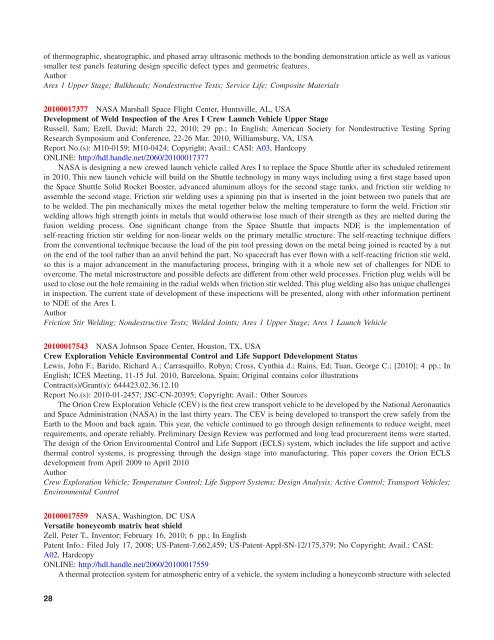NASA Scientific and Technical Aerospace Reports - The University ...
NASA Scientific and Technical Aerospace Reports - The University ...
NASA Scientific and Technical Aerospace Reports - The University ...
Create successful ePaper yourself
Turn your PDF publications into a flip-book with our unique Google optimized e-Paper software.
of thermographic, shearographic, <strong>and</strong> phased array ultrasonic methods to the bonding demonstration article as well as various<br />
smaller test panels featuring design specific defect types <strong>and</strong> geometric features.<br />
Author<br />
Ares 1 Upper Stage; Bulkheads; Nondestructive Tests; Service Life; Composite Materials<br />
20100017377 <strong>NASA</strong> Marshall Space Flight Center, Huntsville, AL, USA<br />
Development of Weld Inspection of the Ares I Crew Launch Vehicle Upper Stage<br />
Russell, Sam; Ezell, David; March 22, 2010; 29 pp.; In English; American Society for Nondestructive Testing Spring<br />
Research Symposium <strong>and</strong> Conference, 22-26 Mar. 2010, Williamsburg, VA, USA<br />
Report No.(s): M10-0159; M10-0424; Copyright; Avail.: CASI: A03, Hardcopy<br />
ONLINE: http://hdl.h<strong>and</strong>le.net/2060/20100017377<br />
<strong>NASA</strong> is designing a new crewed launch vehicle called Ares I to replace the Space Shuttle after its scheduled retirement<br />
in 2010. This new launch vehicle will build on the Shuttle technology in many ways including using a first stage based upon<br />
the Space Shuttle Solid Rocket Booster, advanced aluminum alloys for the second stage tanks, <strong>and</strong> friction stir welding to<br />
assemble the second stage. Friction stir welding uses a spinning pin that is inserted in the joint between two panels that are<br />
to be welded. <strong>The</strong> pin mechanically mixes the metal together below the melting temperature to form the weld. Friction stir<br />
welding allows high strength joints in metals that would otherwise lose much of their strength as they are melted during the<br />
fusion welding process. One significant change from the Space Shuttle that impacts NDE is the implementation of<br />
self-reacting friction stir welding for non-linear welds on the primary metallic structure. <strong>The</strong> self-reacting technique differs<br />
from the conventional technique because the load of the pin tool pressing down on the metal being joined is reacted by a nut<br />
on the end of the tool rather than an anvil behind the part. No spacecraft has ever flown with a self-reacting friction stir weld,<br />
so this is a major advancement in the manufacturing process, bringing with it a whole new set of challenges for NDE to<br />
overcome. <strong>The</strong> metal microstructure <strong>and</strong> possible defects are different from other weld processes. Friction plug welds will be<br />
used to close out the hole remaining in the radial welds when friction stir welded. This plug welding also has unique challenges<br />
in inspection. <strong>The</strong> current state of development of these inspections will be presented, along with other information pertinent<br />
to NDE of the Ares I.<br />
Author<br />
Friction Stir Welding; Nondestructive Tests; Welded Joints; Ares 1 Upper Stage; Ares 1 Launch Vehicle<br />
20100017543 <strong>NASA</strong> Johnson Space Center, Houston, TX, USA<br />
Crew Exploration Vehicle Environmental Control <strong>and</strong> Life Support Ddevelopment Status<br />
Lewis, John F.; Barido, Richard A.; Carrasquillo, Robyn; Cross, Cynthia d.; Rains, Ed; Tuan, George C.; [2010]; 4 pp.; In<br />
English; ICES Meeting, 11-15 Jul. 2010, Barcelona, Spain; Original contains color illustrations<br />
Contract(s)/Grant(s): 644423.02.36.12.10<br />
Report No.(s): 2010-01-2457; JSC-CN-20395; Copyright; Avail.: Other Sources<br />
<strong>The</strong> Orion Crew Exploration Vehicle (CEV) is the first crew transport vehicle to be developed by the National Aeronautics<br />
<strong>and</strong> Space Administration (<strong>NASA</strong>) in the last thirty years. <strong>The</strong> CEV is being developed to transport the crew safely from the<br />
Earth to the Moon <strong>and</strong> back again. This year, the vehicle continued to go through design refinements to reduce weight, meet<br />
requirements, <strong>and</strong> operate reliably. Preliminary Design Review was performed <strong>and</strong> long lead procurement items were started.<br />
<strong>The</strong> design of the Orion Environmental Control <strong>and</strong> Life Support (ECLS) system, which includes the life support <strong>and</strong> active<br />
thermal control systems, is progressing through the design stage into manufacturing. This paper covers the Orion ECLS<br />
development from April 2009 to April 2010<br />
Author<br />
Crew Exploration Vehicle; Temperature Control; Life Support Systems; Design Analysis; Active Control; Transport Vehicles;<br />
Environmental Control<br />
20100017559 <strong>NASA</strong>, Washington, DC USA<br />
Versatile honeycomb matrix heat shield<br />
Zell, Peter T., Inventor; February 16, 2010; 6 pp.; In English<br />
Patent Info.: Filed July 17, 2008; US-Patent-7,662,459; US-Patent-Appl-SN-12/175,379; No Copyright; Avail.: CASI:<br />
A02, Hardcopy<br />
ONLINE: http://hdl.h<strong>and</strong>le.net/2060/20100017559<br />
A thermal protection system for atmospheric entry of a vehicle, the system including a honeycomb structure with selected<br />
28

















